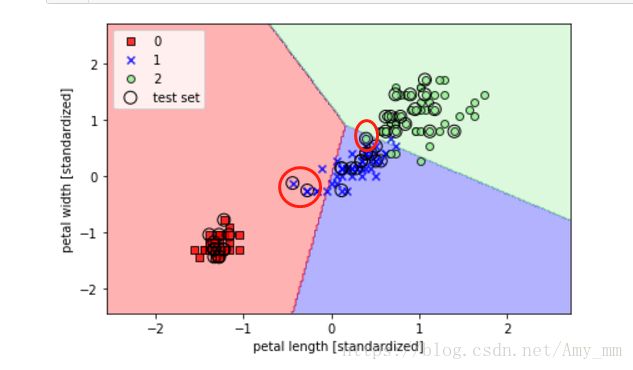scikit-learn 学习总结 (一)——sklearn实现感知机(perceptron)
学习《python machine learning》 的第三章,A Tour of Machine Learning Classifiers Using scikit-learn
本章主要讲述 特征选择 和 数据预处理,以下算法实现都是基于sklearn的接口~~~~
生命不息,学习不止~ 哈哈哈哈
【训练一个机器学习模型的五大关键步骤:】
(1)选择特征,收集训练样本
(2)选择性能指标
(3)选择分类器和优化算法
(4)评估模型性能
(5)调整算法(调参)
【training a percetron】
sklearn中自带了一些数据集,比如iris数据集,Iris数据中data存储花瓣长宽(column0,1)和花萼长宽(column2,3).
target存储花的分类,Iris-setosa , Iris-versicolor , and Iris-virginica ,分别存储为数字 0,1,2
【收集训练样本】
from sklearn import datasets
import numpy as np
iris = datasets.load_iris()
X = iris.data[:,[2, 3]]
y = iris.target
print(np.unique(y))
【 train_test_split 分为训练集和测试集】
train_test_split 将数据集分为训练集和测试集,test_size参数决定测试集的比例。
random_state参数是随机数生成种子,在分类前将数据打乱,保证数据的可重复利用。
stratify 保证训练集和测试集中花的三大类的比例与输入比例相同。
【验证分层分类 stratification】
from sklearn.model_selection import train_test_split
#train_test_split
X_train, X_test, y_train, y_test = train_test_split(X, y, test_size = 0.3,
random_state = 1, stratify = y )
#bincount
print("Labels counts in y: ",np.bincount(y))
print("Labels counts in y_train: ", np.bincount(y_train))
print("Labels counts in y_test: ", np.bincount(y_test))【特征标准化 Standardize the feature】
运用sklearn preprocessing模块的StandardScaler类对特征值进行标准化
StandardScaler( )函数参考自
http://scikit-learn.org/stable/modules/generated/sklearn.preprocessing.StandardScaler.html
fit ( )函数计算平均值和标准差
transform()运用fit计算的mean和std deviation 进行数据的标准化
from sklearn.preprocessing import StandardScaler
sc = StandardScaler()
sc.fit(X_train)
X_train_std = sc.transform(X_train)
X_test_std = sc.transform(X_test)【train perceptron model】
#train perceptron model
from sklearn.linear_model import Perceptron
ppn = Perceptron(n_iter = 40, eta0 = 0.1, random_state = 1)
ppn.fit(X_train_std, y_train)
y_pred = ppn.predict(X_test_std)
miss_classified = (y_pred != y_test).sum()
print("MissClassified: ",miss_classified)【metrics model 选择新能指标】
accuracy_score
from sklearn.metrics import accuracy_score
print('Accuracy : % .2f' % accuracy_score(y_pred, y_test))或者 Perceptron.score() ——结合predict()函数和accuracy_score()函数 返回感知机的预测正确率
参数为predict的参数
print("Accuracy Score : % .2f" % ppn.score(X_test_std,y_test))【画分离超平面】
#画超平面
from matplotlib.colors import ListedColormap
import matplotlib.pyplot as plt
def plot_decision_regions(X, y, classifier, test_idx=None, resolution=0.02):
# setup marker generator and color map
markers = ('s', 'x', 'o', '^', 'v')
colors = ('red', 'blue', 'lightgreen', 'gray', 'cyan')
cmap = ListedColormap(colors[:len(np.unique(y))])
# plot the decision surface
x1_min, x1_max = X[:, 0].min() - 1, X[:, 0].max() + 1
x2_min, x2_max = X[:, 1].min() - 1, X[:, 1].max() + 1
xx1, xx2 = np.meshgrid(np.arange(x1_min, x1_max, resolution),
np.arange(x2_min, x2_max, resolution))
Z = classifier.predict(np.array([xx1.ravel(), xx2.ravel()]).T)
Z = Z.reshape(xx1.shape)
plt.contourf(xx1, xx2, Z, alpha=0.3, cmap=cmap)
plt.xlim(xx1.min(), xx1.max())
plt.ylim(xx2.min(), xx2.max())
for idx, cl in enumerate(np.unique(y)):
plt.scatter(x=X[y == cl, 0],
y=X[y == cl, 1],
alpha=0.8,
c=colors[idx],
marker=markers[idx],
label=cl,
edgecolor='black')
# highlight test samples
if test_idx:
# plot all samples
X_test, y_test = X[test_idx, :], y[test_idx]
plt.scatter(X_test[:, 0],
X_test[:, 1],
c='',
edgecolor='black',
alpha=1.0,
linewidth=1,
marker='o',
s=100,
label='test set')#htack vstack 水平叠加和垂直叠加
X_combined_std = np.vstack((X_train_std,X_test_std))
y_combined_std = np.hstack((y_train, y_test))
plot_decision_regions(X = X_combined_std,
y = y_combined_std,
classifier = ppn,
test_idx = range(105,150))
plt.xlabel('petal length [standardized]')
plt.ylabel('petal width [standardized]')
plt.legend(loc = 'upper left')
plt.tight_layout()
plt.show()
可以看到圈出的三个错误分类点(我圈出的,不是plot出来的)~~~
感知机只能对线性数据进行正确分类,对于非线性数据,可以采用逻辑回归等分类方法。见下一篇博文 ——sklearn实现逻辑回归。

